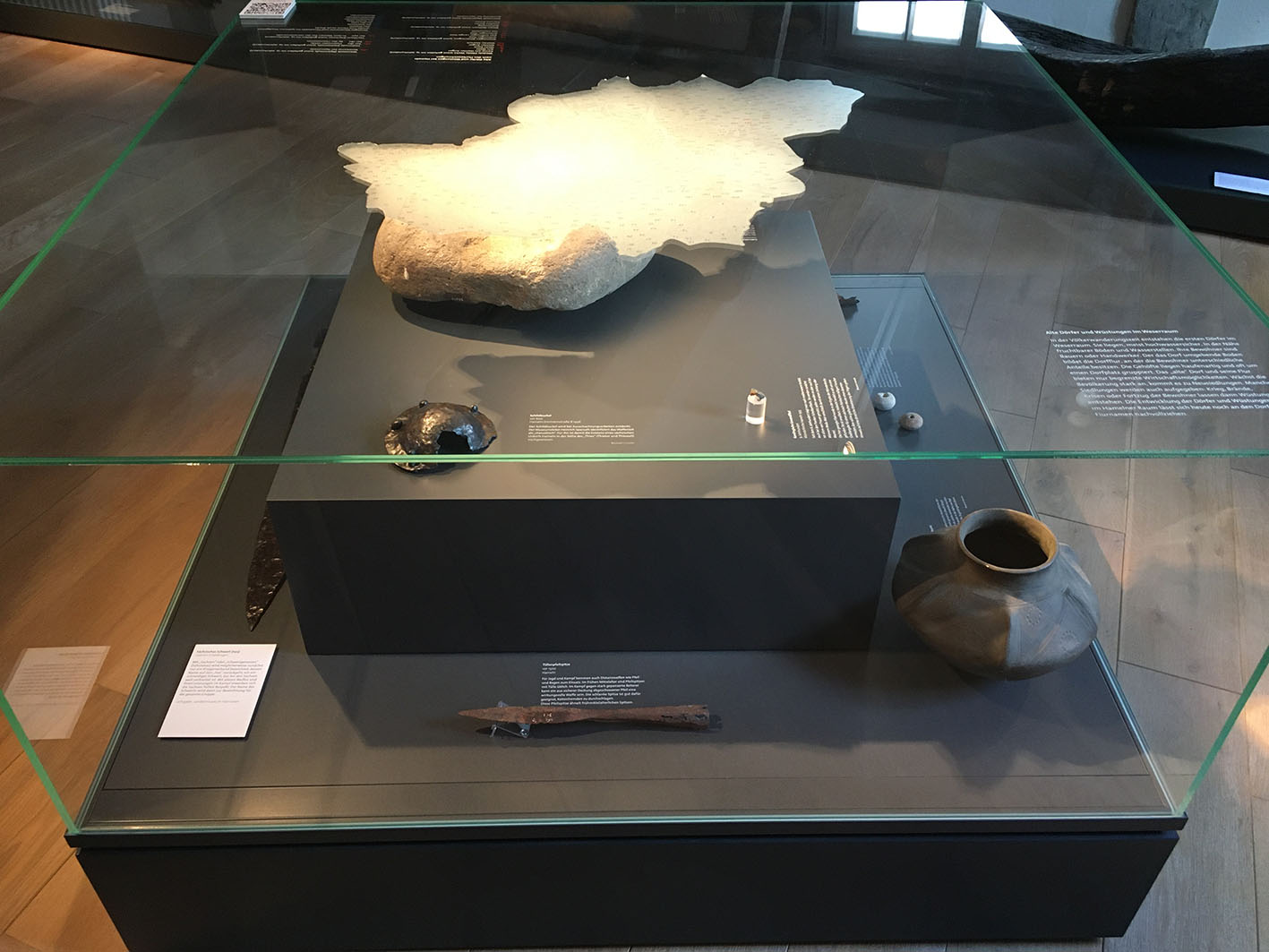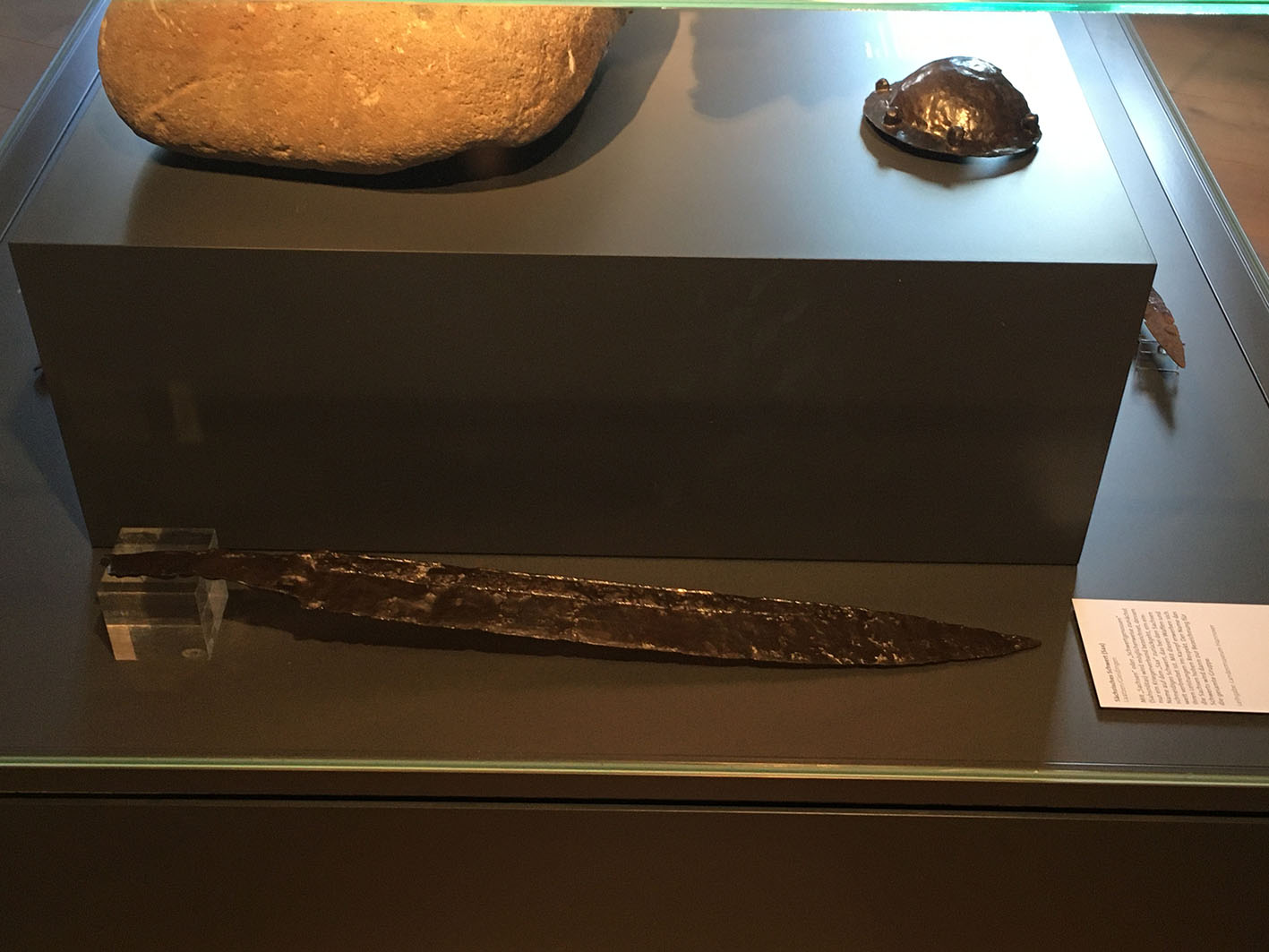
The Middle Ages, © Museum Hameln
The Middle Ages
In the 6th Century the christianisation of Germanic tribes begins. Around 800 A.D. the Saxons capitulate to the Franconian, King Karl. The Christian franconian Kingdom changes its name to the “Holy Roman Empire”. Internal and external conflicts weaken the kingdom. Dukedoms are formed.
The relationship between all those of noble descent is set out clearly: the rulers give land and rights to the upper class, who in turn pledge their loyalty to the rulers. Most people live in villages, practising subsistence farming. Everyone has his designated place in society: noblemen, clergy and farmers. With the development of large towns and cities, a new class is born, the “citizen”.

Saxony, © Museum Hameln
What Existed before Hameln?
The roots of the present-day city can be traced back to prehistoric times. The later city is situated in an area that is already largely developed. Since Neolithic times people have been settling there. These settlements continue being used through the Bronze and Iron Ages. Important trade routes meet in the floodplain of Hameln.
From the 8th Century onwards, this area falls under the rule of the Saxons. Saxons live on single farms or groups of rural communities. Over time these develop into small towns. Free farmers form the core of these communities. Next down in the hierarchy are the agricultural workers, herdsmen and craftsmen. Most of the towns belong to Saxony counts.
Up to this day it is not clear whether a town Hameln actually existed or not. What is more likely, is that the city was founded anew at the centre of the surrounding towns. Some of them are deserted later on, as people start migrating to the city.
Old villages and deserted medieval towns in the River Weser area
The first villages in the Weser area arose during the Migration Period. They usually lay safe from floods near fertile land and water holes. Their inhabitants were farmers or craftsmen. The land surrounding the village was owned by the inhabitants in the form of various plots. The farmsteads lay grouped in clusters and often around a village square. The “old” village and its land only offered limited economic potential. If the population grew quickly, then new settlements would arise. Some settlements were also abandoned: war, fire, crises or outward migration of inhabitants then left behind deserted medieval towns. The development of villages and deserted medieval towns in the Hamelin area can be retraced today in the village and land names.
Old villages and deserted medieval towns in Hamelin according to land names
Wedele (Wele, Wehl, abandoned in the 15th century)
3 Kamp am Wehler Anger
4 Am Wehl
17 Wehl Bach
204 Wehler Anger
207 Wehler Marsch
Groningen (Gröningen, abandoned in the 14th century)
115 Gröninger Feld
116 Das Gröninger Lange Feld
117 Gröninger Feld
121 Die Hausstelle
Büren (Bühren, abandoned in the 15th century)
382 Bührenweg
384 Großen Büren
385 Kleinen Büren
Nienstedt (Nyenstedt, abandoned in the 15th century)
289 Rovekamp bei Nyenstede
Hohnrode (Hohenroth, abandoned in the 14th century)
484 bei 180 Hoenroder velde
485 bei 180 By der Hoensworth
Harthem (Hartmer, abandoned in the 14th century)
515 bei 250 In dem Westen bei der Hartmerstraße
Arms of the Weser that have run dry and river islands in the late city area
170 Große und Kleine Faule Breite
172 Der Ihlpohl
174 De lakebrede
175 An der Lake
176 Im faulen Orte
349 Scheckenwerder
350 Besselerswerder
351 Wulveswerder
Saxon embossed urn (replica)
5th century, Bad Pyrmont 1651
Embossed urns were a characteristic ceramic form of the early Saxons. They were still called urns, though it has long since not been clear if they were only used as such.
The ornamental container shown here was found near Bad Pyrmont. It is evidence for this region having been an early part of Saxon culture.
Spindle whorl for hand spinning
9th/10th Century
Since the Neolithic Age, fabric and clothing made of wool and linen have been manufactured in households. This work predominantly took place in so-called pithouses. These were buildings sunk into the ground which ay removed from the living quarters. They were described by the Roman author Tacitus in his “Germania”.
Many such buildings were found during digging on the land of the former community centre (today ECE). In some of them, spindle whorls were found, indicating spinning and weaving in the Early Middle Ages. They could also have related to a suburban, village settlement “Hamelon”.
Lance tips
undated | before 1300 | Hamelin? | Hamelin/lock construction
The lance and sword, together with the spear, were the main weapons in the wars of the Early Middle Ages. The lance was a thrust weapon used in close combat. The weapon was developed into the cavalier lance with the rise of the military cavalry. If two cavalrymen engaged in battle, they defended themselves against the enemy’s lance thrust with a specially shaped shield and attempted to strike with their own lance. This form of combat was orchestrated in chivalric tournaments until the Late Middle Ages.
Saxon sword (sax)
Laatzen/Gleidingen
Possibly only a band of warriors was meant in the first instance by “Saxon” or “sword comrades” (Sahsnôtas), the name originating from the “sax”, a single-edged sword widespread among the Saxons. The Saxons commanded high respect with these weapons and their performance in battle. The name of the sword then became an appellation for the whole group.
Item on loan: Landesmuseum Hannover
Socketed arrowhead
before 1500, Hamelin
Ranged weapons such as the bow and arrow were also used for hunting and combat. Arrowheads with sockets were typical in the Early Middle Ages. An arrow launched from secure cover could be an effective weapon in battle against heavily armoured cavalry. The narrow tip is well-suited to the penetration of chain mail.
This arrowhead resembles those in the Early Middle Ages.
Shield boss
before 600, Hamelin/Emmernstraße 8 1936
The shield boss was discovered during excavation work. The head of the museum, Heinrich Spanuth, identifies the weapon part as “Cheruscan”. The existence of an ancient Saxon village of Hamelin near the “Thies” (Thietor and Thiewall) is for him thereby proven.
Carolingian garment brooch
9th century, Hamelin Cathedral 1955
From the 6th century, following the Mediterranean example, Franconians also wore disc brooches. At first, they were mostly used by women, but later they also became fashionable for men. They were used for closing cloaks or overcoats.
The brooch shown here was found in the cathedral crypt. It is enamelled. Maybe it is a burial object for a Saxon-Franconian noble? Researchers presume that such graphical patterns provide a decent indication of the Christian orientation of the wearer.
Anchor stone from the Early Middle Ages
Hamelin/Werder 1936
The anchor stone from the Early Middle Ages shows that the River Weser, replete with fish, was used in early times. A boat could be held in the current during fishing with the help of such simple, perforated stones. The often-found net sinkers took a similar form. They held the fish nets on the riverbed.

Showcase with Saxon objects, © Museum Hameln
Saxon embossed urn (replica)
5th century, Bad Pyrmont 1651
Embossed urns were a characteristic ceramic form of the early Saxons. They were still called urns, though it has long since not been clear if they were only used as such.
The ornamental container shown here was found near Bad Pyrmont. It is evidence for this region having been an early part of Saxon culture.
Spindle whorl for hand spinning
9th/10th Century
Since the Neolithic Age, fabric and clothing made of wool and linen have been manufactured in households. This work predominantly took place in so-called pithouses. These were buildings sunk into the ground which ay removed from the living quarters. They were described by the Roman author Tacitus in his “Germania”.
Many such buildings were found during digging on the land of the former community centre (today ECE). In some of them, spindle whorls were found, indicating spinning and weaving in the Early Middle Ages. They could also have related to a suburban, village settlement “Hamelon”.
Lance tips
undated | before 1300 | Hamelin? | Hamelin/lock construction
The lance and sword, together with the spear, were the main weapons in the wars of the Early Middle Ages. The lance was a thrust weapon used in close combat. The weapon was developed into the cavalier lance with the rise of the military cavalry. If two cavalrymen engaged in battle, they defended themselves against the enemy’s lance thrust with a specially shaped shield and attempted to strike with their own lance. This form of combat was orchestrated in chivalric tournaments until the Late Middle Ages.
Socketed arrowhead
before 1500, Hamelin
Ranged weapons such as the bow and arrow were also used for hunting and combat. Arrowheads with sockets were typical in the Early Middle Ages. An arrow launched from secure cover could be an effective weapon in battle against heavily armoured cavalry. The narrow tip is well-suited to the penetration of chain mail.
This arrowhead resembles those in the Early Middle Ages.
Shield boss
before 600, Hamelin/Emmernstraße 8 1936
The shield boss was discovered during excavation work. The head of the museum, Heinrich Spanuth, identifies the weapon part as “Cheruscan”. The existence of an ancient Saxon village of Hamelin near the “Thies” (Thietor and Thiewall) is for him thereby proven.
Carolingian garment brooch
9th century, Hamelin Cathedral 1955
From the 6th century, following the Mediterranean example, Franconians also wore disc brooches. At first, they were mostly used by women, but later they also became fashionable for men. They were used for closing cloaks or overcoats.
The brooch shown here was found in the cathedral crypt. It is enamelled. Maybe it is a burial object for a Saxon-Franconian noble? Researchers presume that such graphical patterns provide a decent indication of the Christian orientation of the wearer.
Anchor stone from the Early Middle Ages
Hamelin/Werder 1936
The anchor stone from the Early Middle Ages shows that the River Weser, replete with fish, was used in early times. A boat could be held in the current during fishing with the help of such simple, perforated stones. The often-found net sinkers took a similar form. They held the fish nets on the riverbed.

Saxon sword, © Museum Hameln
Saxon sword (sax)
Laatzen/Gleidingen
Possibly only a band of warriors was meant in the first instance by “Saxon” or “sword comrades” (Sahsnôtas), the name originating from the “sax”, a single-edged sword widespread among the Saxons. The Saxons commanded high respect with these weapons and their performance in battle. The name of the sword then became an appellation for the whole group.
Item on loan: Landesmuseum Hannover
